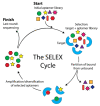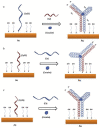A Bottom-Up Approach for Developing Aptasensors for Abused Drugs: Biosensors in Forensics
- PMID: 31581533
- PMCID: PMC6955935
- DOI: 10.3390/bios9040118
A Bottom-Up Approach for Developing Aptasensors for Abused Drugs: Biosensors in Forensics
Abstract
Aptamer-based point-of-care (POC) diagnostics platforms may be of substantial benefit in forensic analysis as they provide rapid, sensitive, user-friendly, and selective analysis tools for detection. Aptasensors have not yet been adapted commercially. However, the significance of the applications of aptasensors in the literature exceeded their potential. Herein, in this review, a bottom-up approach is followed to describe the aptasensor development and application procedure, starting from the synthesis of the corresponding aptamer sequence for the selected analyte to creating a smart surface for the sensitive detection of the molecule of interest. Optical and electrochemical biosensing platforms, which are designed with aptamers as recognition molecules, detecting abused drugs are critically reviewed, and existing and possible applications of different designs are discussed. Several potential disciplines in which aptamer-based biosensing technology can be of greatest value, including forensic drug analysis and biological evidence, are then highlighted to encourage researchers to focus on developing aptasensors in these specific areas.
Keywords: custom-tailored aptamers; electrochemical biosensors; forensic sciences; optical biosensors; point-of-care (POC).
Conflict of interest statement
The authors declare no conflict of interest.
Figures








References
-
- Thompson T., Black S. Forensic Human Identification: An Introduction. CRC Press; Boca Raton, FL, USA: 2006.
-
- Manchikanti L., Malla Y., Wargo B.W., Fellows B. Comparative evaluation of the accuracy of benzodiazepine testing in chronic pain patients utilizing immunoassay with liquid chromatography tandem mass spectrometry (LC/MS/MS) of urine drug testing. Pain Physician. 2011;14:259–270. - PubMed
Publication types
MeSH terms
Substances
Grants and funding
LinkOut - more resources
Full Text Sources

